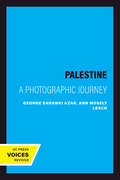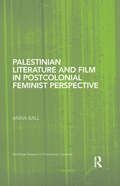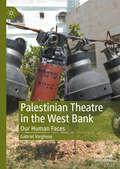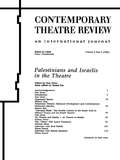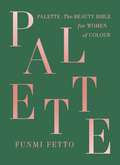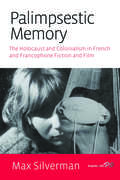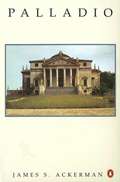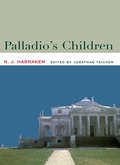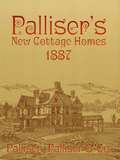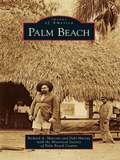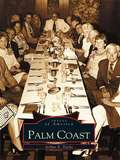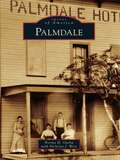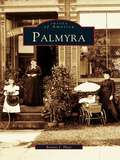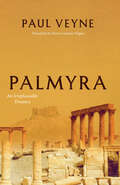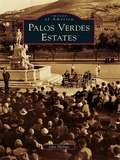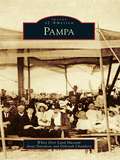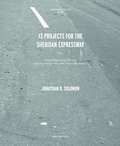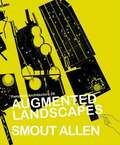- Table View
- List View
Palestine: A Photographic Journey
by George Baramki AzarThis title is part of UC Press's Voices Revived program, which commemorates University of California Press’s mission to seek out and cultivate the brightest minds and give them voice, reach, and impact. Drawing on a backlist dating to 1893, Voices Revived makes high-quality, peer-reviewed scholarship accessible once again using print-on-demand technology. This title was originally published in 1991.
Palestinian Literature and Film in Postcolonial Feminist Perspective (Routledge Research in Postcolonial Literatures)
by Anna BallPalestinian Literature and Film in Postcolonial Feminist Perspective is the first sustained study of gender-consciousness in the Palestinian creative imagination. Drawing on concepts from postcolonial feminist theory, Ball analyses a range of literary and filmic works by major creative practitioners including Michel Khleifi , Liana Badr, Annemarie Jacir, Elia Suleiman, Mona Hatoum and Suheir Hammad, and reveals a hitherto unrecognized trajectory in gender-consciousness under development in the Palestinian imagination from the start of the twentieth century. The book explores how these works resonate with questions of power, identity, nation, resistance, and self-representation in the Palestinian imagination more broadly, and asks how these gender-conscious narratives transform our understanding of Palestine's struggle for postcoloniality. Working at the cusp of postcolonial, feminist and cultural enquiry, Ball seeks to open up vital new directions in the interdisciplinary study of Palestine.
Palestinian Theatre in the West Bank: Our Human Faces
by Gabriel VargheseSince the 1990s, Palestinian theatrical activities in the West Bank have expanded exponentially. As well as local productions, Palestinian theatre-makers have presented their work to international audiences on a scale unprecedented in Palestinian history. This book explores the histories of the five major theatre companies currently working in the West Bank: Al-Kasaba Theatre, Ashtar Theatre, Al-Harah Theatre, The Freedom Theatre and Al-Rowwad. Taking the first intifada (1987-93) as his point of departure, and drawing on original fieldwork and interviews with Palestinian practitioners, Gabriel Varghese introduces the term ‘abject counterpublics’ to explore how theatre-makers contest Zionist discourse and Israeli state practices. By foregrounding Palestinian voices, and placing theories of abjection and counterpublic formation in conversation with each other, Varghese argues that theatre in the West Bank has been regulated by processes of colonial abjection and, yet, it is an important site for resisting Zionism's discourse of erasure and Israeli settler-colonialism and apartheid. Palestinian Theatre in the West Bank: Our Human Faces is the first major account of Palestinian theatre covering the last three decades.
Palestinians and Israelis in the Theatre
by Dan UrianThe Jewish-Israeli theatre is a complex and developed system in which the dispute with the Palestinians constitutes just one of the important components in its repertoire; while the Palestinian theatre, both within and outside of Israel, is being consolidated. This work brings together these two approaches by relating to the Palestinian theme as it appears in the Jewish-Israeli theatre and by attempting to characterize the Palestinian theatre in general.
Palette Knife Painting in Acrylics: Projects, Techniques & Inspiration to Get You Started
by Tim FisherAdd vibrancy and texture to your acrylic paintings!Perfect for those new to palette knife painting, Tim Fisher's inspirational guide is the ideal introduction, combining clear instructions and step-by-step photographs with aspirational paintings.Palette knives for painting come in a wide range of shapes and sizes, and can be used in a variety of ways, at different angles, to apply acrylic paint thickly and freely for rich, textural results.Discover the range of techniques you can try, and marks you can make from delicate dots to thick slabs of colour; then progress to a series of eight projects, from a simple yet effective row of bold, blocky beach huts, right through to a challenging yet incredibly satisfying and striking sunset scene of Bamburgh Castle, Northumberland, painted on a black background for huge visual impact.Use your palette knives alongside traditional paintbrushes to introduce texture and dimension into your paintings, and discover how to combine classic painting techniques with mixed-media and collage featuring found objects.
Palette: A Black Beauty Bible
by Funmi Fetto'The beauty bible we've all been dreaming of' BUSTLE'Dedicated to women of colour, but one that we all can learn from.' CAROLINE HIRONSAS FEATURED IN GLAMOUR, METRO, DAILY TELEGRAPH AND OBSERVER AN INDEPENDENT SELECTION FOR AUTUMN 2019A GRAZIA BEAUTY BOOK CLUB PICK'This ground-breaking, first-of-its-kind book is not only destined to become the beauty bible for women of colour everywhere, it is also a significant, relevant and influential voice in the conversation around inclusivity. Essential reading' EDWARD ENNINFULThe idea for Palette came to Vogue Contributing Beauty Editor Funmi Fetto after years of being asked by friends, family and strangers on the street for advice on products suitable for women of colour, who often find themselves excluded from mainstream beauty coverage. Following on from her career in journalism where she has extended the beauty conversation in publications such as the Observer - for whom she writes a weekly column - and written in an honest, elegant and engaging style, Fetto covers all the hair, skincare, makeup and body products available today which really work for women of colour.'If anyone is going to decode beauty's most inclusive and brilliant products, it should be Funmi. This woman really knows her stuff and delivers it in such warm and chatty way. It's a bit like going shopping with your very beauty savvy best friend who happens to have a wicked sense of humour' LISA ELDRIDGE 'Warm, witty and welcoming' GAL-DEM
Palette: A Black Beauty Bible
by Funmi Fetto'The beauty bible we've all been dreaming of' BUSTLE'Dedicated to women of colour, but one that we all can learn from.' CAROLINE HIRONSAS FEATURED IN GLAMOUR, METRO, DAILY TELEGRAPH AND OBSERVERAN INDEPENDENT SELECTION FOR AUTUMN 2019A GRAZIA BEAUTY BOOK CLUB PICK'This ground-breaking, first-of-its-kind book is not only destined to become the beauty bible for women of colour everywhere, it is also a significant, relevant and influential voice in the conversation around inclusivity. Essential reading' EDWARD ENNINFULThe idea for Palette came to Vogue Contributing Beauty Editor Funmi Fetto after years of being asked by friends, family and strangers on the street for advice on products suitable for women of colour, who often find themselves excluded from mainstream beauty coverage. Following on from her career in journalism where she has extended the beauty conversation in publications such as the Observer - for whom she writes a weekly column - and written in an honest, elegant and engaging style, Fetto covers all the hair, skincare, makeup and body products available today which really work for women of colour.'If anyone is going to decode beauty's most inclusive and brilliant products, it should be Funmi. This woman really knows her stuff and delivers it in such warm and chatty way. It's a bit like going shopping with your very beauty savvy best friend who happens to have a wicked sense of humour' LISA ELDRIDGE 'Warm, witty and welcoming' GAL-DEM
Palimpsestic Memory
by Max SilvermanThe interconnections between histories and memories of the Holocaust, colonialism and extreme violence in post-war French and Francophone fiction and film provide the central focus of this book. It proposes a new model of 'palimpsestic memory', which the author defines as the condensation of different spatio-temporal traces, to describe these interconnections and defines the poetics and the politics of this composite form. In doing so it is argued that a poetics dependent on tropes and techniques, such as metaphor, allegory and montage, establishes connections across space and time which oblige us to perceive cultural memory not in terms of its singular attachment to a particular event or bound to specific ethno-cultural or national communities but as a dynamic process of transfer between different moments of racialized violence and between different cultural communities. The structure of the book allows for both the theoretical elaboration of this paradigm for cultural memory and individual case-studies of novels and films.
Palladio
by James Ackerman Phyllis MassarPalladio (1508-80) combined classical restraint with constant inventiveness. In this study, Professor Ackerman sets Palladio in the context of his age - the Humanist era of Michelangelo and Raphael, Titian and Veronese - and examines each of the villas, churches and palaces in turn and tries to penetrate to the heart of the Palladian miracle. Palladio's theoretical writings are important and illuminating, he suggests, yet they never do justice to the intense intuitive skills of "a magician of light and colour". Indeed, as the photographs in this book reveal, Palladio was "as sensual, as skilled in visual alchemy as any Venetian painter of his time", and his countless imitators have usually captured the details, but not the essence of his style. There are buildings all the way from Philadelphia to Leningrad which bear witness to Palladio's "permanent place in the making of architecture", yet he also deserves to be seen on his own terms.
Palladio's Children: Essays on Everyday Environment and the Architect
by N.J. HabrakenBased on many years of personal observation, Palladio's Children critically examines the role of the architect as a professional descendent of Palladio, and as an heir to his architectural legacy. Seven innovative and carefully crafted essays explore the widening ideological schism between today’s architects whose core values, identity and education remain rooted in the Renaissance legacy of creating artful ‘masterpieces’, and the practical demands on a profession which acts within an evolving, ubiquitous and autonomous built environment or ‘field’. Clearly written yet expressing complex, evolving ideas, this extended argument opens a new forum of debate across design theory, professional practice and academic issues. Moving the subject on from a historical perspective, Habraken shows how architects are increasingly involved in the design of everyday buildings. This must lead to a reassessment of architects’ identities, values and education, and the contribution of the architect in the shaping of the built environment.
Pallet Style: 20 Creative Home Projects Using Recycled Wooden Pallets
by Nikkita PalmerFrom sofas to shelving to a stylish home bar, Pallet Style shows you how to create your own furniture using reclaimed wooden pallets. Whether you want to make something in a weekend or are embarking on a more complex bespoke piece for your home, each of Nikkita and Billy's projects are stylish design solutions, perfect for Scandi-influenced urban apartments or rustic retreats.An introductory section explains the different kinds of standard pallets, many of which can be sourced for free as they are so readily available. Full instructions for deconstructing a pallet are provided, together with ideas on how to source them.The projects are divided into three sections - Furniture, Storage & Display and Accessories - each project includes full step-by-step instructions and photographs. In furniture, find out how to construct a bed, a home bar or a coffee table. Storage & Display features makes for a display shelf, a herb box planter and a log 'basket', as well as a recycling centre for your kitchen. In Accessories, find out how to make key hooks, a breakfast tray and a festival sign.
Palliser's New Cottage Homes
by Palliser Co.Meticulous reproduction of the now-rare catalog -- originally issued in 1887 -- includes 1,500 detailed drawings of floor plans, elevations, perspective views, architectural details, and interior ornamentation; designs for villas, farmhouses, town and country places, barns, and city brick block houses; and fine-lined illustrations of windows, eaves, and other architectural elements.
Palm Beach
by Richard A. Marconi Historical Society of Palm Beach County Debi MurrayPalm Beach is known internationally as a winter resort where the wealthy enjoy life in a tropical paradise. More than 100 years ago, Palm Beach was far different from its well-kept beaches, estates, and fabulous Worth Avenue shopping mecca of the 21st century. When the first permanent settlers arrived, they found the area covered by thick jungle that had to be tamed before they could carve out a new life for themselves. The settlers ended up with a paradise, and when Henry Flagler decided to build a grand hotel in Palm Beach, he planted the first seed for the creation of a modern winter retreat for the rich.
Palm Coast (Images of America)
by Arthur E. DyckeWhat is paradise? Before 1969, land that would eventually become the City of Palm Coast was considered by some as nothing more than a "big pine-covered swamp." But when the corporate eyes of ITT/Levitt and Sons looked upon the virtually uninhabited land, they saw 22,000 acres of golf courses, marinas, oceanfront motels, scenic drives, and house lots awaiting the arrival of sun-seeking "pioneers." Marketing strategies targeting urban residents in the North and Midwest offered slices of land cut out of miles of forest, and soon a 500-mile infrastructure of roads, utilities, and sewer lines bound Palm Coast to a future that included becoming the largest planned unit development in Florida history.
Palm Springs Holiday
by Peter MoruzziExplore the glamor and style of Palm Springs in its golden age with this gorgeously illustrated book of vintage photographs, postcards and other ephemera. From the 1910s through the 1960s, Palm Springs, California, was a city that had it all, including marvelous midcentury Modern architecture, fabulous fly-in hotels, and a swinging nightlife. Featuring vintage images of the area&’s famous hotels and gambling dens, as well as the Coachella Valley, Palm Springs Holiday tells the story of this legendary destination in its golden age. Author and architectural historian Peter Moruzzi provides essential historical context as well as insightful and engaging commentary about a time when people vacationed in the desert, dining, dancing, and lounging poolside.
Palmdale
by Norma H. Gurba Nicholas J. WestOne of the nation's fastest growing cities and a center for the aerospace and defense industries, Palmdale began in 1886 with the doomed colony of Palmenthal in a land plentiful with Joshua trees and jackrabbits but very little water. The gateway to the southern Antelope Valley, Palmdale has enjoyed a rich, diverse, and eventful history while resourceful pioneers created neighboring communities of unique character. Littlerock, a "pearadise," became the fruit basket for the Antelope Valley. Neil Armstrong, before becoming the first man to walk on the moon in 1969, resided in Juniper Hills. Pearblossom's rustic landscape was ideal for early cowboy movies. The crumbling site of Llano del Rio is the location of perhaps the most important nonreligious utopian colony in Western American history. Valyermo owes its existence to the San Andreas Fault, and the Big Rock Creek area became known for Noah Beery Sr.'s Paradise Trout Club, a favorite rendezvous for many Hollywood movie stars and notables.
Palmyra (Images of America)
by Bonnie J. HaysPalmyra reveals the fascinating history of the place known as "the Queen of Canal Towns." Vivid photographs highlight life as it was in this Wayne County community, which is visited by more than two hundred thousand people each year. Shown are military men and abolitionists, inventors and entrepreneurs, the founder of the Church of Jesus Christ of Latter-day Saints and the Hill Cumorah, site of the largest outdoor theater production in the United States.
Palmyra: An Irreplaceable Treasure
by Paul Veyne Teresa Lavender FaganLocated northeast of Damascus, in an oasis surrounded by palms and two mountain ranges, the ancient city of Palmyra has the aura of myth. According to the Bible, the city was built by Solomon. Regardless of its actual origins, it was an influential city, serving for centuries as a caravan stop for those crossing the Syrian Desert. It became a Roman province under Tiberius and served as the most powerful commercial center in the Middle East between the first and the third centuries CE. But when the citizens of Palmyra tried to break away from Rome, they were defeated, marking the end of the city’s prosperity. The magnificent monuments from that earlier era of wealth, a resplendent blend of Greco-Roman architecture and local influences, stretched over miles and were among the most significant buildings of the ancient world—until the arrival of ISIS. In 2015, ISIS fought to gain control of the area because it was home to a prison where many members of the outlawed Muslim Brotherhood had been held, and ISIS went on to systematically destroy the city and murder many of its inhabitants, including the archaeologist Khaled al-Asaad, the antiquities director of Palymra. In this concise and elegiac book, Paul Veyne, one of Palymra’s most important experts, offers a beautiful and moving look at the history of this significant lost city and why it was—and still is—important. Today, we can appreciate the majesty of Palmyra only through its pictures and stories, and this book offers a beautifully illustrated memorial that also serves as a lasting guide to a cultural treasure.
Palomino
by Elizabeth JolleyPALOMINO Laura is in her fifties, a gynecologist now barred from her profession. For ten years, she has lived alone on a remote valley farm in self-imposed isolation. Then, returning by ship from a journey around the world (meant as an act of self-healing, -to reawaken her senses), Laura sees Andrea, a young woman whose golden hair and complexion remind her of the beautiful palomino horses that run together in paddocks in clear view of her verandah. Later, by chance, the two women meet at a dinner party, and to Laura's delight, Andrea insists on an extended visit to Laura's farm. Here, they share early morning walks in the jarrah forest, evenings of music and intimate conversation, and much reading-of diaries and letters, in particular. In this idyllic setting, amid orchards and rain storms, each woman seeks to make herself known to the other. The passion that blossoms is rare and deeply felt. As time passes, events long suppressed are revealed, unorthodox entanglements of friendship and love and a bizarre medical accident (or was it murder?).
Palos Verdes Estates
by John PhillipsSituated on the westernmost cliffs of the Palos Verdes Peninsula, the city of Palos Verdes Estates continues to fulfill former landowner and developer Frank Vanderlip's vision of the area as the nation's "most fashionable and exclusive residential colony," and it remains one of Los Angeles County's most affluent cities. Development of open land began in 1922 under the direction of landscape designer Frederick Law Olmsted Jr. One of the first master-planned communities in the United States, Palos Verdes Estates (PVE) became the first of the four peninsula cities to be incorporated, in 1939. Early community life revolved around the Palos Verdes Golf Club, La Venta Inn, Malaga Cove School, and the charming Malaga Cove and Lunada Bay commercial areas, both of which have been graced by their own distinctive fountains. The Malaga Cove Library, a fine example of Early Californian design executed by architect Myron Hunt in 1930, was placed on the National Register of Historic Places in 1995.
Pampa
by Anne Davidson White Deer Land Museum Deborah ChambersThe Panhandle's first railroad, the Southern Kansas Railway of Texas, was constructed in 1886. Reaching Amarillo in 1889, the railway pulled cars filled with immigrant families and their belongings. The settlers were farmers from the east and south who came west to find water and cheap land. George Tyng, an adventurous fortune seeker, began leasing ranch land in 1887. A rail station was constructed, and Tyng eventually settled on the name "Pampa," a South American word that means "plains." Tyng was fond of saying that someday Pampa would be the "Queen City of the Plains."
Pamper Your Pooch: 30 Practical Presents For Dogs
by Rachelle BlondelThey say that dog is a man's (and woman's!) best friend - so show your pooch how much you care by making any one of the 30 lovingly handcrafted projects in this book. Divided into four chapters - Eat, Nest, Play, Wear - the ideas are practical as well as cute and include everything, from the Rest A Weary Head Bed, Plaited Fetch Toy and Travelling Dog Bed to the Jaunty Neckerchief and Bow Tie for Boys, and allow you to pamper your pet without spending a fortune. There is even a Bath Day Towel and Muddy Paw Towel, as well as a Dog Coat for the fashionable four-legged friend and recipes for Bitesize Biscuits and the ultimate Doggie Birthday Cake!
Pamper Your Pooch: 30 practical presents for dogs
by Rachelle BlondelThey say that dog is a man's (and woman's!) best friend - so show your pooch how much you care by making any one of the 30 lovingly handcrafted projects in this book. Divided into four chapters - Eat, Nest, Play, Wear - the ideas are practical as well as cute and include everything, from the Rest A Weary Head Bed, Plaited Fetch Toy and Travelling Dog Bed to the Jaunty Neckerchief and Bow Tie for Boys, and allow you to pamper your pet without spending a fortune. There is even a Bath Day Towel and Muddy Paw Towel, as well as a Dog Coat for the fashionable four-legged friend and recipes for Bitesize Biscuits and the ultimate Doggie Birthday Cake!
Pamphlet Architecture 26
by Jonathan D. SolomonThe thirteen projects take as their subject a site of contested transportation infrastructure--the Sheridan Expressway. By proposing new typologies for this site, these studies seek to mediate the spaces in the city where local and regional meet. Referencing the introduction of the modern parkway into the Bronx, the grading of the Central Park transverse roads, and other works that have redefined the relationship between parks and roads, author Jonathan Solomon suggests a system by which large projects might again be built in American cities.
Pamphlet Architecture 28
by Laura Allen Mark SmoutIn 1977 Steven Holl and William Stout created a grittier alternative to mainstream architectural publishing called Pamphlet Architecture. With Holl's Bridges, the landmark series was born, and for 30 years Pamphlet has served as soapbox and laboratory for such notable architects and theorists as Lebbeus Woods, Zaha Hadid, Lars Lerup, and Michael Sorkin. With its twenty-eighth installment, Pamphlet Architecture celebrates its thirtieth anniversary no less bold than when it began. Augmented Landscapes features a landscape architecture practice for the first time in Pamphlet history. London's Smout Allen presents five projects that respond to the way in which man has enlarged the landscape through architecture and infrastructure, manipulating and blurring perceptions of what is natural and what is artificial.
